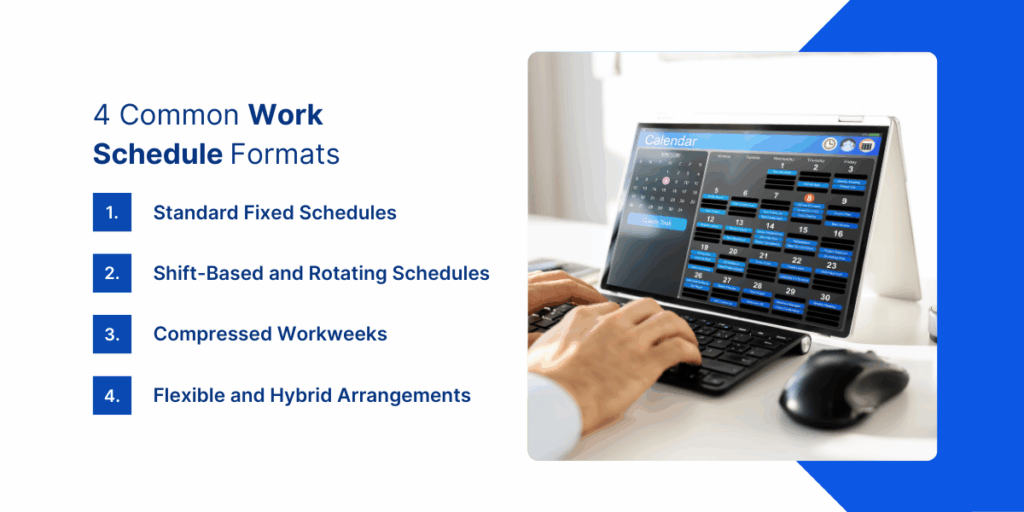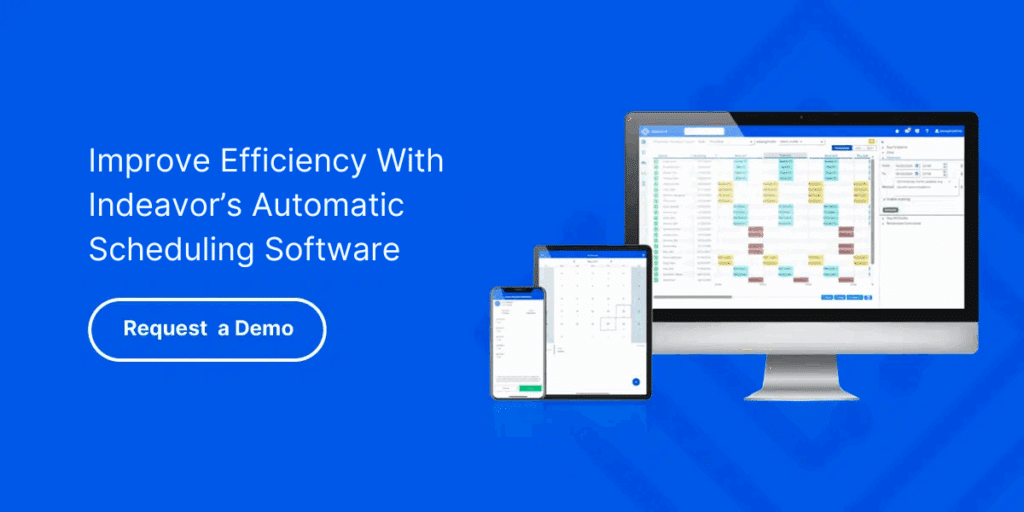You may be wondering, what is a work schedule?
Work schedules are structured plans that define when employees start and end work, which days they work, and how shifts are organized. They serve as a framework, often digital, that aligns workforce management objectives with employee needs. This ensures the right people are in place when needed while supporting autonomy, well-being, and operational efficiency.
Despite their importance, many organizations still rely on inflexible or outdated work schedules, which can hurt engagement, productivity, and overall workforce performance.
Common Work Schedule Formats
Work schedules come in several commonly known formats, each designed to meet different operational needs. Understanding the different types of schedules helps organizations plan staffing effectively and ensure employees know what to expect.
Standard Fixed Schedules
Standard fixed schedules assign employees set hours, often 9 to 5, Monday through Friday. They are widely used in traditional office, retail, and administrative settings and provide predictability for both staff and managers.
Employees know exactly when their shifts begin and end, which simplifies planning personal activities and maintaining routine. Fixed schedules also make it easy for managers to ensure coverage during core business hours.
Shift-Based and Rotating Schedules
Shift-based and rotating schedules are common in industries that operate around the clock, such as healthcare, manufacturing, and customer service. Employees may rotate through early, mid, or late shifts to cover all operational hours.
These schedules allow organizations to maintain continuous operations while distributing work fairly across employees. Shift patterns are typically planned in advance to provide clarity for staff and ensure smooth transitions between shifts.
Compressed Workweeks
Compressed workweeks allow employees to complete their standard hours over fewer days, such as four 10-hour days instead of five 8-hour days. This arrangement can give employees longer weekends while still maintaining full-time work schedules.
Compressed schedules are often used in offices or teams that benefit from longer consecutive periods of off time. They can also help reduce commuting days for employees and create concentrated periods of productivity.
Flexible and Hybrid Arrangements
Hybrid and flexible work schedules allow employees to adjust their start and end times or split their work between on-site and remote locations. These schedules are increasingly common in knowledge-based roles and organizations that support work-life balance.
Flexible arrangements provide employees with more control over their daily routines while still meeting organizational goals. They are usually supported by digital workforce management tools that help coordinate schedules and track hours efficiently.

Why These Schedules Often Fail Employees
Even the most common work schedules can create challenges when they are not designed with employees in mind. Poorly managed schedules can negatively affect engagement, productivity, and overall workforce satisfaction. Understanding the key reasons why schedules fail helps organizations address these issues effectively.
- Lack of Employee Autonomy: Many work schedules are imposed top-down. Employees rarely have input into when they work or what suits their lifestyle, leaving them feeling undervalued and disengaged. In fact, 41% of U.S. employees have little or no control over their work schedules, according to Gallup.
- Poor Communication and Visibility: When schedules are updated but not shared clearly, employees are left guessing their shifts. This confusion can lead to frustration, absenteeism, and decreased reliability. 27% of U.S. employees experience schedule unpredictability, highlighting how common this problem is.
- One-Size-Fits-All Approach: Uniform scheduling ignores diversity in employees’ lives, such as parenting responsibilities, commuting challenges, or health needs. Without flexibility, even high-performing staff may disengage.
- Compliance and Well-Being Risks: Manual scheduling can inadvertently violate labor laws regarding overtime, rest periods, or predictable hours. This not only stresses employees but also exposes organizations to legal and operational risk.
- Managerial Burden: Overburdened managers scramble to fill gaps, manage last-minute shifts, and correct errors. Valuable leadership time is lost to administrative tasks instead of strategic workforce management.
Addressing these failures requires intentional workforce management strategies, including better communication, flexible scheduling options, and automated tools that align operational needs with employee well-being. Organizations that take these steps can create schedules that work for both employees and the business.
How Indeavor’s Approach Is Different
Modern scheduling requires more than just filling shifts. It needs to balance operational demands with employee satisfaction. Indeavor approaches work schedules with tools and processes designed to make scheduling fair, flexible, and efficient while reducing administrative burden.
Some of the key ways Indeavor is revolutionizing scheduling include:
- Flexible by Design: Supports different work schedule types, including fixed, compressed, and hybrid schedules, while giving employees some control over their shifts.
- Transparent and Accessible: Ensures everyone can view real-time updates through mobile or desktop interfaces, eliminating confusion and last-minute surprises.
- Personalized and Automated: Incorporates rules for compliance, fairness, and operational needs, automatically distributing shifts based on qualifications and availability.
- Compliance Focused: Flags potential violations before schedules are published, helping organizations stay within labor regulations.
- Human-Centered Experience: Offers a clean, intuitive interface that makes it easy for managers and employees to navigate scheduling tasks without frustration.
By combining flexibility, transparency, automation, and compliance, Indeavor provides a scheduling system that supports both the organization and its workforce. The result is higher engagement, better operational efficiency, and a more satisfied team.

Actionable Tips for Managers
Creating work schedules that support both employees and operational goals requires intentional planning and clear communication. Managers who take a proactive approach to scheduling can improve engagement, decrease absenteeism, and maintain productivity across teams.
Here are some actionable strategies for managers:
- Plan Around Operational Peaks: Review historical data to identify periods of high demand. Schedule the right mix of employees during these times to maintain productivity without overloading staff. This approach ensures coverage while keeping workloads balanced.
- Incorporate Employee Preferences: Allow team members to provide input on preferred shifts or days off. Even small adjustments can improve morale, reduce last-minute swap requests, and enhance overall engagement.
- Use Technology for Scheduling: Implement workforce management or employee scheduling software to streamline shift planning. Digital tools can automate conflict detection, track availability, and ensure compliance with labor regulations, freeing managers from manual scheduling burdens.
- Communicate Clearly and Early: Publish schedules well in advance and make them easily accessible to all employees. Transparent scheduling reduces confusion, absenteeism, and stress, and helps employees plan their personal lives around work.
- Offer Flexibility with Boundaries: Provide options for flexible or hybrid schedules where possible, but maintain clear guidelines for coverage. This allows employees to manage work-life balance while ensuring the organization continues to meet operational needs.
- Regularly Review and Adjust: Monitor schedule effectiveness through employee feedback and operational metrics. Adjust shifts, staffing levels, or rules as needed to improve fairness, efficiency, and overall workforce satisfaction.
By following these strategies, managers can create work schedules that meet business needs while supporting employees’ well-being and engagement. Thoughtful scheduling strengthens workforce management practices and contributes to a more productive, satisfied team.
The Impact of Better Scheduling
Research continues to show that scheduling is more than just an operational function. It has direct implications for employee health, engagement, and organizational performance. Companies that ignore scheduling improvements risk higher turnover, disengagement, and compliance issues.
A Harvard study found that hourly workers given more predictable schedules through a “fair workweek” initiative reported improvements in their sleep, well-being, and financial security. These findings prove that small, thoughtful adjustments to a work schedule can have significant positive outcomes for both employees and employers.
According to Forbes, only 31% of U.S. employees were actively engaged at work in 2024, the lowest level in a decade. This statistic highlights disengagement as a pressing workforce management challenge and underscores how flawed work schedules deepen disengagement and how improving them can uplift morale and productivity.
Next Steps
Outdated work schedules are more than just administrative oversight. They undermine employee autonomy, well-being, and operational resilience. Organizations that continue with rigid or opaque scheduling strategies risk disengaging their workforce and exposing themselves to both productivity losses and compliance gaps.
It doesn’t have to be this way. By adopting a modern, transparent, and automated approach, built with tools like employee scheduling software, leaders can transform scheduling from an operational burden into a strategic advantage.
Request a demo with Indeavor to see how a smarter, more human-focused approach to scheduling can boost engagement, reduce turnover, and empower a thriving workforce.
About the Author
Claire Pieper is the Digital Marketing Specialist for Indeavor. In her role, she specializes in crafting strategic and engaging content, ensuring that customers are well-informed. Claire is dedicated to enhancing the customer experience and optimizing the user journey through Indeavor’s solutions. To learn more or get in touch, connect with Claire on LinkedIn.



